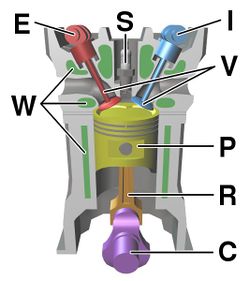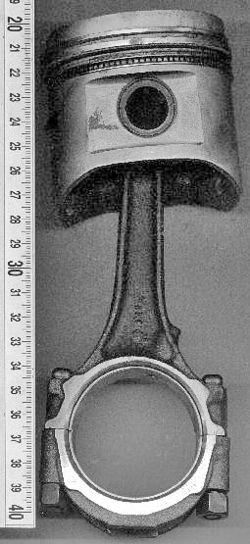Difference between revisions of "Piston"
Jump to navigation
Jump to search

| (2 intermediate revisions by 2 users not shown) | |||
| Line 1: | Line 1: | ||
[[Image:Four stroke engine diagram.jpg|thumbnail|right|Components of a typical, [[four stroke cycle]], DOHC piston engine. (E) Exhaust [[camshaft]], (I) Intake camshaft, (S) [[Spark plug]], (V) [[poppet valve|Valve]]s, '''(P) Piston''', (R) [[Connecting rod]], (C) [[Crankshaft]], (W) Water jacket for coolant flow.]] | [[Image:Four stroke engine diagram.jpg|thumbnail|right|Components of a typical, [[four stroke cycle]], DOHC piston engine. (E) Exhaust [[camshaft]], (I) Intake camshaft, (S) [[Spark plug]], (V) [[poppet valve|Valve]]s, '''(P) Piston''', (R) [[Connecting rod]], (C) [[Crankshaft]], (W) [[Water jacket]] for coolant flow.]] | ||
[[Image:Piston and connecting rod.jpg|thumbnail|right|Piston and connecting rod]] | [[Image:Piston and connecting rod.jpg|thumbnail|right|Piston and connecting rod]] | ||
A piston is a component of reciprocating [[engines]], pumps and gas compressors. It is located in a cylinder and is made gas-tight by piston rings. In an engine, its purpose is to transfer force from expanding gas in the cylinder to the [[crankshaft]] via a piston rod and/or [[connecting rod]]. In a pump, the function is reversed and force is transferred from the crankshaft to the piston for the purpose of compressing or ejecting the fluid in the cylinder. In some engines ([[two-strokes]]), the piston also acts as a valve by covering and uncovering ports in the cylinder wall. | A piston is a component of reciprocating [[engines]], pumps and gas compressors. It is located in a cylinder and is made gas-tight by [[piston rings]]. In an engine, its purpose is to transfer force from expanding gas in the cylinder to the [[crankshaft]] via a piston rod and/or [[connecting rod]]. In a pump, the function is reversed and force is transferred from the crankshaft to the piston for the purpose of compressing or ejecting the fluid in the cylinder. In some engines ([[two-strokes]]), the piston also acts as a valve by covering and uncovering ports in the cylinder wall. | ||
==Oversize pistons== | |||
*1st => std. | |||
*2nd => 0.25mm | |||
*3rd => 0.50mm | |||
*4th => 0.75mm | |||
*5th => 1.00mm | |||
[[Category:Definitions]] | [[Category:Definitions]] | ||
Latest revision as of 00:52, 30 November 2010

Components of a typical, four stroke cycle, DOHC piston engine. (E) Exhaust camshaft, (I) Intake camshaft, (S) Spark plug, (V) Valves, (P) Piston, (R) Connecting rod, (C) Crankshaft, (W) Water jacket for coolant flow.
A piston is a component of reciprocating engines, pumps and gas compressors. It is located in a cylinder and is made gas-tight by piston rings. In an engine, its purpose is to transfer force from expanding gas in the cylinder to the crankshaft via a piston rod and/or connecting rod. In a pump, the function is reversed and force is transferred from the crankshaft to the piston for the purpose of compressing or ejecting the fluid in the cylinder. In some engines (two-strokes), the piston also acts as a valve by covering and uncovering ports in the cylinder wall.
Oversize pistons[edit | edit source]
- 1st => std.
- 2nd => 0.25mm
- 3rd => 0.50mm
- 4th => 0.75mm
- 5th => 1.00mm
